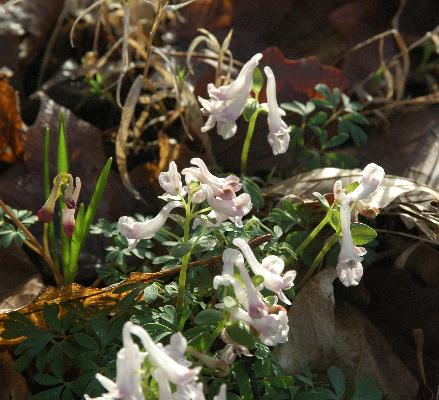Corydalis
My post the other day of tender bulbs that are hardy here did not touch on one group that I am fond of: Corydalis.
Corydalis solida varieties do well here in open shade settings, as long as you don't let grass grow in among them. I tried naturalizing Corydalis solida and Fritillaria meleagris in grassy areas with only light shade. They were crowded out by the grass.
In the woodland garden, C. solida sets seed and volunteers come up in the gravel walks. In its place, it does just fine here. Most of my patches of solida are in areas that get at least a little irrigation in the driest parts of summer.
Corydalis lutea (properly now called Pseudofumaria lutea) has never managed to get established here, for some reason. It seems to die within a year each time I try it. C. ochroleuca (Pseudofumaria ochroleuca) lived and bloomed for several years but eventually died out.
Corydalis shanginii lived and bloomed for several years in full sun, but gradually disappeared. I suppost it was done in by the summer heat.
C. angustifolia 'Georgian White' not only survived, it blooms and increases. It also seeds around modestly, so I am very pleased with it. It is growing in a rough bed at the edge of the woodland garden. It gets some irrigation in summer, although I don't know whether it needs it or not. C. kuznetzovii lasted a long time, flowering every year, but did not seem to increase from one small clump.
Corydalis bracteata did well, survived, increased, and bloomed, in one small spot. Moved elsewhere, it simply disappears. It's a fine yellow Corydalis, but you have to guess at just the right place for it.
Numerous other species have survived here, even bloomed, for a few years. If they were less expensive I would recommend planting them again when they disappear. Since they tend to be had to find (Janis Ruksans is the only source I can think of for many), I've not replaced any of them. These included CC. caucasica, paczoskii, turczaninowii, wendelboi, and some others.

Corydalis kuznetzovii from 2008
I have found that the blue flowered Corydalis species, including elata, flexuosa, and linstowiana, are impossible to grow here except that linstowiana (ex Dufu) in pots did survive and bloom in the cool greenhouse. The linstowiana pots spent the summer outdoors in the lath house under occasional misting. The other blue ones appear to be hopeless.
Depending on the weather, the Corydalis should be blooming here in central Indiana in about two or three months. The bulbous one should be planted when they are dormant, usually in summer. The fibrous-rooted species should be moved whenever you can get them, using great care, especially if they are in leaf.
Good gardening, from here in central Indiana
Jim
Look up technical terms in the Glossary of Plant Biology